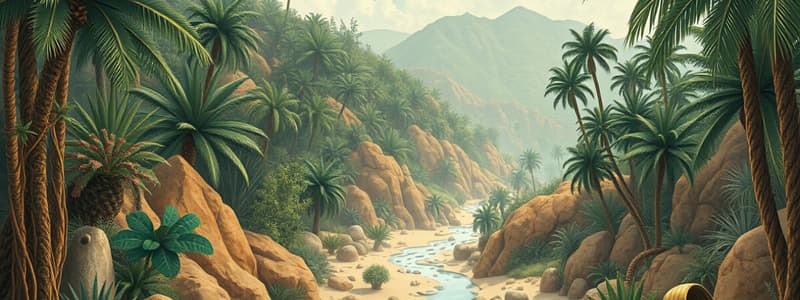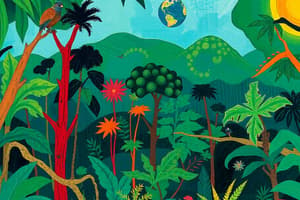Podcast
Questions and Answers
Where are tropical rainforests primarily located?
Where are tropical rainforests primarily located?
Near the equator
What is the average temperature range in tropical rainforests?
What is the average temperature range in tropical rainforests?
- 25-30°C
- 10-15°C
- 15-20°C
- 20-25°C (correct)
Tropical rainforests are known for having nutrient-rich soil.
Tropical rainforests are known for having nutrient-rich soil.
False (B)
What adaptations do succulents have to survive in deserts?
What adaptations do succulents have to survive in deserts?
What is a characteristic of the climate in deserts?
What is a characteristic of the climate in deserts?
Grasslands have a high number of trees due to their wet climate.
Grasslands have a high number of trees due to their wet climate.
What types of trees dominate temperate forests?
What types of trees dominate temperate forests?
What is a common characteristic of taiga climate?
What is a common characteristic of taiga climate?
Match the following ecosystems with their characteristics:
Match the following ecosystems with their characteristics:
What role do grasslands serve in ecosystems?
What role do grasslands serve in ecosystems?
Flashcards are hidden until you start studying
Study Notes
Tropical Rainforest Ecosystems
- Location: Near the equator; found in regions such as the Amazon Basin, Congo Basin, and Southeast Asia.
- Climate: High rainfall (200-450 cm/year), warm temperatures (20-25°C), high humidity.
- Biodiversity:
- Home to over half of the world's plant and animal species.
- Vertical stratification: emergent layer, canopy, understory, and forest floor.
- Soil: Generally poor in nutrients due to rapid decomposition and nutrient uptake by plants.
- Ecosystem Services: Carbon storage, oxygen production, and habitat for numerous species.
Desert Adaptations
- Location: Found in regions with low precipitation; examples include the Sahara, Mojave, and Gobi deserts.
- Climate: Extremely low rainfall (less than 25 cm/year), high temperature fluctuations between day and night.
- Flora Adaptations:
- Succulents (e.g., cacti) store water in their tissues.
- Deep root systems to access underground water.
- Waxy coatings on leaves to reduce water loss.
- Fauna Adaptations:
- Nocturnal behavior to avoid daytime heat.
- Specialized kidneys and intestines to conserve water.
- Some species, like the kangaroo rat, can survive without drinking water.
Temperate Forest Characteristics
- Location: Found in eastern North America, Europe, and parts of Asia.
- Climate: Moderate rainfall (75-150 cm/year), four distinct seasons, and average temperatures ranging from -30°C to 30°C.
- Flora:
- Dominated by deciduous trees (e.g., oak, maple) and some evergreen conifers (e.g., pine, spruce).
- Rich understory of shrubs and herbaceous plants.
- Fauna: Diverse species including deer, bears, birds, and insects; many animals exhibit seasonal behavior (e.g., hibernation).
- Soil: Fertile, rich in organic matter due to leaf litter decomposition.
Grassland Biodiversity
- Location: Found in regions such as the North American prairies, African savannas, and Eurasian steppes.
- Climate: Moderate rainfall (25-75 cm/year), with hot summers and cold winters.
- Flora:
- Dominated by grasses; few trees due to periodic drought and fires.
- Deep-rooted plants that can survive periods of low water.
- Fauna: Supports large herbivores (e.g., bison, antelope) and their predators (e.g., wolves, lions).
- Ecosystem Role: Important for carbon storage, soil formation, and providing habitat for diverse species.
Taiga Climate and Flora
- Location: Coniferous forest biome primarily found in Canada, Alaska, Russia, and northern Europe.
- Climate: Cold climate, with long winters and short, mild summers; average precipitation (30-85 cm/year), mostly as snow.
- Flora:
- Dominated by coniferous trees (e.g., spruce, fir, pine) adapted to cold temperatures.
- Acidic, nutrient-poor soils due to needle leaf litter.
- Fauna: Species adapted to cold climates, including moose, bears, lynxes, and various bird species.
- Ecosystem Importance: Plays a critical role in carbon cycling and provides habitat for many species.
Tropical Rainforest Ecosystems
- Location centered around the equator, notably in the Amazon, Congo, and Southeast Asia.
- Characterized by high rainfall (200-450 cm/year) and warm, humid conditions (20-25°C).
- Houses over half of global plant and animal biodiversity with a unique vertical structure: emergent layer, canopy, understory, and forest floor.
- Soil generally poor in nutrients, as rapid decomposition and plant uptake limit nutrient availability.
- Ecosystem services include carbon storage, oxygen production, and providing habitats for countless species.
Desert Adaptations
- Occur in arid regions with low precipitation, such as the Sahara, Mojave, and Gobi deserts.
- Extreme climate with less than 25 cm of rainfall per year and significant temperature shifts between day and night.
- Flora include succulents, which store water, and deep-rooted plants that reach underground water sources.
- Adaptations in fauna include nocturnal behavior to escape daytime heat and specialized kidneys to minimize water loss; some animals, like kangaroo rats, can survive without drinking water.
Temperate Forest Characteristics
- Located in eastern North America, Europe, and parts of Asia.
- Experiences moderate rainfall (75-150 cm/year) and distinct seasonal changes with temperatures ranging from -30°C to 30°C.
- Dominated by deciduous trees (e.g., oak, maple) alongside evergreen conifers (e.g., pine, spruce) and a rich understory of shrubs and herbs.
- Supports diverse fauna, including deer, bears, and birds, with many species exhibiting seasonal behaviors like hibernation.
- Soil is fertile and enriched with organic matter due to the decomposition of leaf litter.
Grassland Biodiversity
- Found in regions like North American prairies, African savannas, and Eurasian steppes.
- Characterized by moderate rainfall (25-75 cm/year) with hot summers and cold winters.
- Flora mainly consists of grasses with few trees, as drought and fire events shape the landscape.
- Habitat supports large herbivores such as bison and antelope, along with their predators like wolves and lions.
- Critical to carbon storage, soil formation, and providing diverse habitats.
Taiga Climate and Flora
- Coniferous forest biome prevalent in Canada, Alaska, Russia, and northern Europe.
- Cold climate featuring long winters and short, mild summers, with average precipitation of 30-85 cm/year, mainly as snow.
- Flora dominated by coniferous trees (e.g., spruce, fir, pine) that are specially adapted to endure cold temperatures.
- Soils are often acidic and nutrient-poor, primarily due to the decomposition of needle leaf litter.
- Hosts fauna adapted to cold environments, including moose, bears, and various bird species, playing a vital role in carbon cycling and biodiversity.
Studying That Suits You
Use AI to generate personalized quizzes and flashcards to suit your learning preferences.




